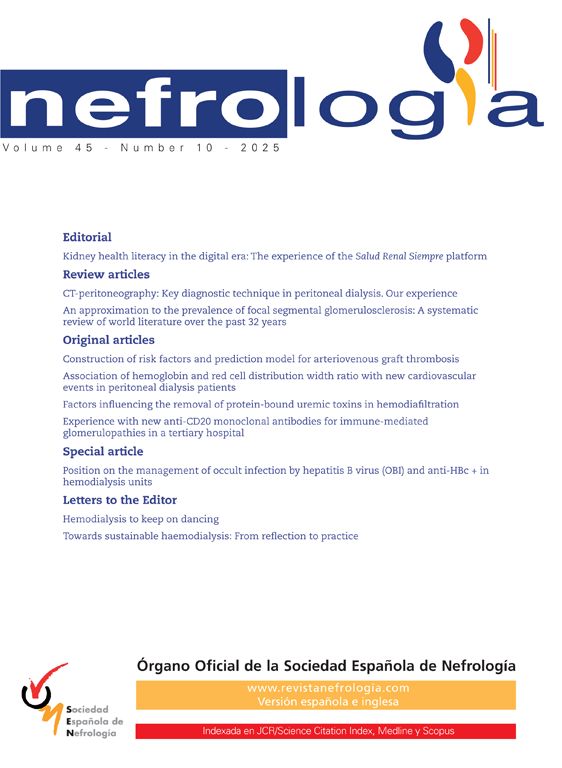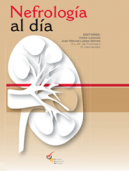Peritoneal infections are relatively frequent among patients on peritoneal dialysis. Most peritonitis evolve well with outpatient treatment, although they can be severe, leading to a greater morbimortality. The most common microorganisms involved are gram-positive germs, although recently peritonitis caused by gram-negative germs has been increasing proportionally. Gram-positive infections are usually related to catheter, line and exit site manipulation, while gram-negative infections can be related with intestinal alterations and pass into the peritoneum via the transmural route. Fungal and anaerobic peritonitis are less frequent, but more severe.1
We present the case of a patient on peritoneal dialysis with peritoneal infection by Delftia lacustris. This is the first case in the literature of peritonitis for this pathogen in the context of a patient on peritoneal dialysis treatment.
This is a 79-year-old man with a history of chronic kidney disease due to focal and segmental glomerulosclerosis diagnosed by renal biopsy in 2017 who initiated peritoneal dialysis in February 2022. Other antecedents included arterial hypertension, dyslipemia and diabetes mellitus type 2.
The patient came to the peritoneal dialysis clinic complaining of abdominal pain and vomiting; in addition he had to cloudy peritoneal fluid. Analysis of the fluid showed 4680 leukocytes with 80% polymorphonuclear. There were signs of peritoneal irritation on palpation. A diagnosis of peritoneal infection was made.2 At this time, cultures were taken and empirical antibiotherapy was started with vancomycin 2 g and gentamicin 80 mg intraperitoneally, continuing with 40 mg of gentamicin daily in addition to oral fluconazole as prophylaxis.2D. lacustris grows in the culture. Following the results of the first culture, antibiotherapy is modified to vancomycin and it is administered a dose of 1 g of ceftazidime, to which it is dose-dependent sensitive. Subsequently, the antibiotic was modified to meropenem 1 g/day intraperitoneally, the only antibiotic with sensitivity at the usual dose. This treatment was maintained for three weeks, with good evolution, but after a week of completing the antibiotic treatment the patient started again with abdominal pain and fever; a new blood sample showed 8113 leukocytes with 81% polymorphonuclear, so antibiotic therapy was reinitiated with meropenem, vancomycin and fluconazole at the same doses and a new culture was performed, where D. lacustris grew again. Treatment with intraperitoneal meropenem was maintained for three weeks, with a good clinical evolution.
Despite this apparent improvement, three weeks later he started again with fever and abdominal pain. The peritoneal fluid showed 4625 leukocytes with 90% polymorphonuclear, and new cultures were taken. This time the patient is in another hospital and the laboratory identified the pathogen as Delftia acidovorans, which presents the same sensitivities as D. lacustris previously, so it is most likely the same pathogen. It was decided treatment with intravenous meropenem 1 g per day and removal of the peritoneal dialysis catheter. Once the catheter was removed, the patient's evolution was satisfactory, with no further infectious symptoms of abdominal origin.
D. lacustris is a gram-negative bacteria with a motile flagellum, first isolated from a lake water in Denmark and later recognized as part of the genus Delftia.3 It is a recognized pathogen in human infections, although rare; it has been associated with vascular catheter bacteremias and eye infections.4,5 Other Delftia species, such as D. acidovorans, have been isolated from peritoneal dialysis abdominal catheter6 and hemodialysis venous catheter,7 but we have not found any cases described by D. lacustris.
D. lacustris has recently been described as an opportunistic germ in vaginal exudate in association with cervical cancer.8 It is thought that D. lacustris infections may be more common than they appear, since laboratories can identify them as D. acidovorans.9
Since we have no record of any travel, and neither has it passed through any lake or similar, and knowing that the germ has been detected as a colonizer in the vagina, it is probably more widespread than we think, and it is possible that it is colonizing human mucous membranes. This pathway could explain the contamination of our patient.
Delftia spp. is generally considered resistant to aminoglycosides, but is usually sensitive to broad-spectrum cephalosporins, piperacillin and aztreonam.5,7 In our case it was treated with meropenem, but relapsed after discontinuation of the antibiotic, so it was necessary to remove the catheter.
In conclusion, infections by bacteria of the genus Delftia may be more common than it appears, as they are generally aminoglycoside-resistant strains but sensitive to meropenem and fluoroquinolones. Bacteria such as D. lacustris and other subspecies of Delftia are often misclassified as D. acidovorans by laboratories, so diagnostic techniques should be optimized to correctly classify the causative germ.





